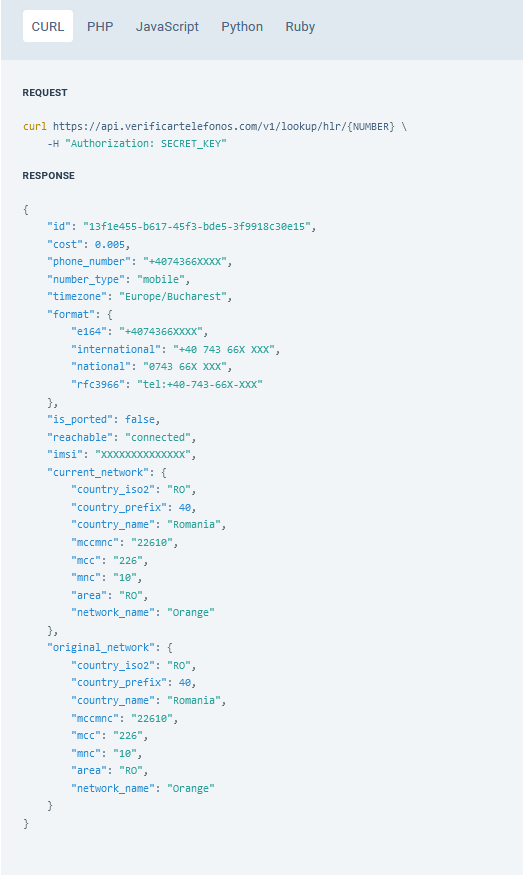We have just launched a new service to verify phone numbers. This service differs from the one we already had for validating telephones in that we can now offer 100% reliability in the validation process and all in real time.
Differences when verifying phone number
There are several ways to validate phone numbers, but we can classify them into 2 main groups.
Validate telephone numbers using communications operators’ networks. This method performs a “simulation” of a call to validate the phone number. With this we are making a deep connection to the phone number. We can offer total reliability in the validation of telephone numbers of mobile terminals.
The main disadvantage is that this type of verification has a cost since it requires access to the private networks of the different operators in order to carry out the verification. Another drawback is that this type of connections, “without making the call”, since the user never knows that we are verifying his number, can only be applied to cell phone numbers. Landline telephone numbers, since they use another type of network, we cannot perform this type of verification.
Syntactic verification of numbers. For landline numbers, the most widespread type of verification is syntactic. What we do is to check that the number is well formed, with the corresponding international calling code and validate it against rules that allow us to obtain the telecommunications operator to which it belongs.
The main advantage of verifying phone numbers syntactically is the low cost, since the whole verification process is performed on our servers. The trade-off is that even if a phone number is syntactically well constructed, it does not mean that it is operational.
Our Api is able to distinguish between fixed and mobile numbers, so you don’t have to worry about which verification method to apply.
Which method is better to validate phone numbers is better
The answer is it depends. If what we are looking for is precision. I would recommend a verification by call “simulation”. If what we are looking for is a low verification cost. Our choice should be syntactic phone verification.
How does it work to verify phone number
We have created a Rest API to perform the number checks. In each call we only have to indicate the telephone number and the service token. It will answer us with a JSON where apart from telling us if the phone number is active, it will give us a lot of information about the operator to which it belongs, if the mobile has been ported, its IMSIcode…

The technical implementation of these calls is very simple, in little more than 5 lines we can integrate this verification in our Web application or backoffice services. In this way we can verify a telephone number in real time.
Como verificar número de teléfono en formularios
Apart from the VerifyEmails Web verification, or using the phone verification API, we have 2 more methods to validate phone numbers.
Widget Validation: A widget is a small piece of JS code that we paste into the Web containing our forms. The fun part is that the code allows you to validate the content of the fields before sending them. This way we get to validate the email, the phone number field or the user’s name / surname… It is the same as we would get through the API but we save all the development work because we generate the code with the Verificaremails wizard.
The generated code is delivered in JavaScript making it compatible with almost all forms regardless of the technology used on the Web.
On the Web we have statistics on the data sent to the form and those who have successfully passed the verification process.
Zapier integration: Zapier is a solution that allows you to connect applications without programming. In this way we can validate the data we capture from any source.
Using the graphical interface we can capture the data we want to verify, there are a multitude of events, each of them depending on the application we connect. For example, we can use the “new record” event in a Google Sheet to check the phone number field once we update the content of our spreadsheet. Through Zapier we will make a call to Verifyemails to validate the content of the cell. It’s as simple as that.
Another implementation we can employ is the use of an Excel file to perform the verification. Just place the numbers one below the other and apply the API call.
All this information not only serves to validate the phone number, but there are companies that use it to create a user profile and see its reliability. Avoiding fraud situations.
Another application for telecommunications service providers is to know the user’s current operator and offer an offer that can better meet their needs. Since we can know at all times the user’s operator and if his number has been ported.
For those of you who want to find out the phone number of a certain contact, we have designed several APIs oriented to lead generation. Use the chat to tell us in detail your needs and we will tell you the best solution.
As you can see using the API for phone verification is a very simple and effective method to keep your database up to date. If you want more information, I recommend you to visit the “Phone verification API documentation” section. To know the costs of phone verification, you can see it in “Phone verification prices”.
Remember that we can not only validate a phone number, but we can also verify an email address to know if it is active 😉
And if you also need to validate emails At Verify Emails, we not only specialize in phone number validation, but we also offer email validation services. Make sure your customers’ email addresses are correct and up to date, which optimizes the effectiveness of your marketing campaigns and increases conversion.



